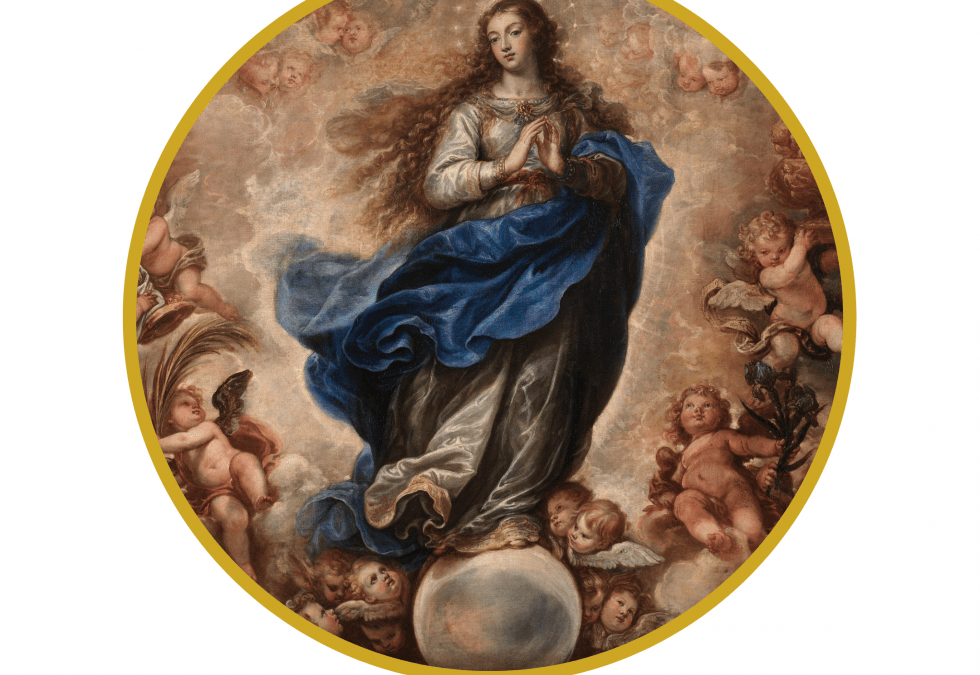
by popadmin | Nov 30, 2021 | CIC Saint Writeups
8 December: Solemnity of the Immaculate Conception of the Blessed Virgin Mary. On this feast day, we celebrate the wondrous moment when the Blessed Virgin began her existence in this world. God allowed her to be conceived without sin in the womb of her mother, Saint Anne. Blessed Mary had the sublime privilege, alone among all human beings and in virtue of the future merits of Christ, of being preserved at the very first moment of conception from the stain of original sin. Mary remained pure from all personal sin throughout her life. Although it falls in the month of December, this great feast does not have any special relationship with Advent. It was fixed on December 8 in order to separate the feast by nine months from the date of the Nativity of the Blessed Virgin (Mary’s birth day) on September 8. However, in celebrating this feast we may easily enter into the spirit of Christmastide, for Mary draws us ever closer to her son, Jesus. Mary is our hope, guide, and mother along the path of salvation. The Immaculate Conception is the Patroness of the United States. How often our Holy Father has stated in recent years that the hope of peace in the world does not lie in force of arms, but rather in prayers and recourse to the intercession of Our Lady. This feast day provides the perfect opportunity for a renewal of love for our country and true devotion to Our Blessed Mother.
Ideas for celebrating this feast day at home:
- Go to mass: the Solemnity of the Immaculate Conception is a holy day of obligation. Have older children listen carefully for references to the doctrine of the Immaculate Conception, not only in the readings and homily, but also in the prayers during the liturgy of the Eucharist.
- Get Patriotic! Our Lady is the Patroness of the United States of America under her title of the “Immaculate Conception.” This is a good month to place an American flag on your home altar or near your statue or picture of Our Lady, and ask for Mary’s intercession for the USA.
- Wear a miraculous medal and make a home display honoring Mary. The miraculous medal bears these fitting words, “O Mary, conceived without sin, pray for us who have recourse to thee.”
- Set your dinner table with a white cloth, white candles, good dishes, and white roses. Place a picture or statue of Mary as the centerpiece.
- To celebrate the sin-less-ness of Mary, how about a WHITE dinner! Ideas: white fish with rice; creamy chicken alfredo with sourdough bread; roasted cauliflower with cheese sauce. Serve it all with a tall glass of white milk!
- Dessert is the fun part! Enjoy a white cake or cupcakes with white icing, vanilla ice cream, meringue cookies, or an angel food cake topped with whipped cream.
- Gather after dinner to read an advent or Marian book aloud to your children. Finish the night by praying a family rosary together.
- Invoke the intercession of Saints Anne and Joachim, parents of our Blessed Mother: pray one of these prayersor novenas to Jesus’s Grandparents.
- Pray a Marian prayer: There are many Marian prayers that you can pray with your kids on the Solemnity of the Immaculate Conception. Ave Maria Stellisis a beautiful song that is traditional to this feast. The Hail Mary and Hail, Holy Queen are basic Marian prayers that are good for kids to know by heart. And the Magnificat, Mary’s own prayer and her longest speaking part in the Bible, is a wonderful prayer for any Marian feast day.
- Service project: make this “Treat a Pregnant Lady” day! There are so many little things that make a day easier for a pregnant mom: taking toddlers for a bit to give mom a break; drop off a meal; etc. If you don’t know a pregnant mom, perhaps take a donation to a local pregnancy crisis center. This feast day provides a great opportunity to transform faith and teaching into good works – teaching children to put their faith into practice.
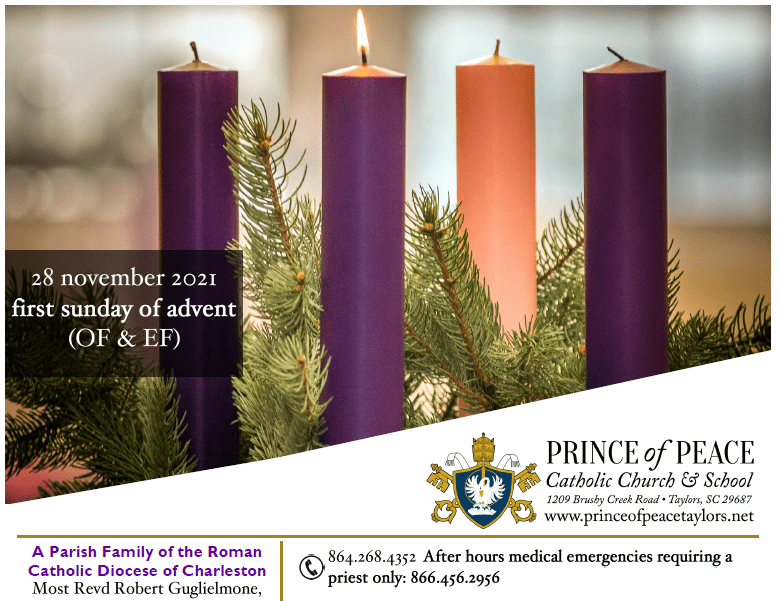
by popadmin | Nov 22, 2021 | Bulletin
Click to read this week’s bulletin: 28 November 2021 Bulletin
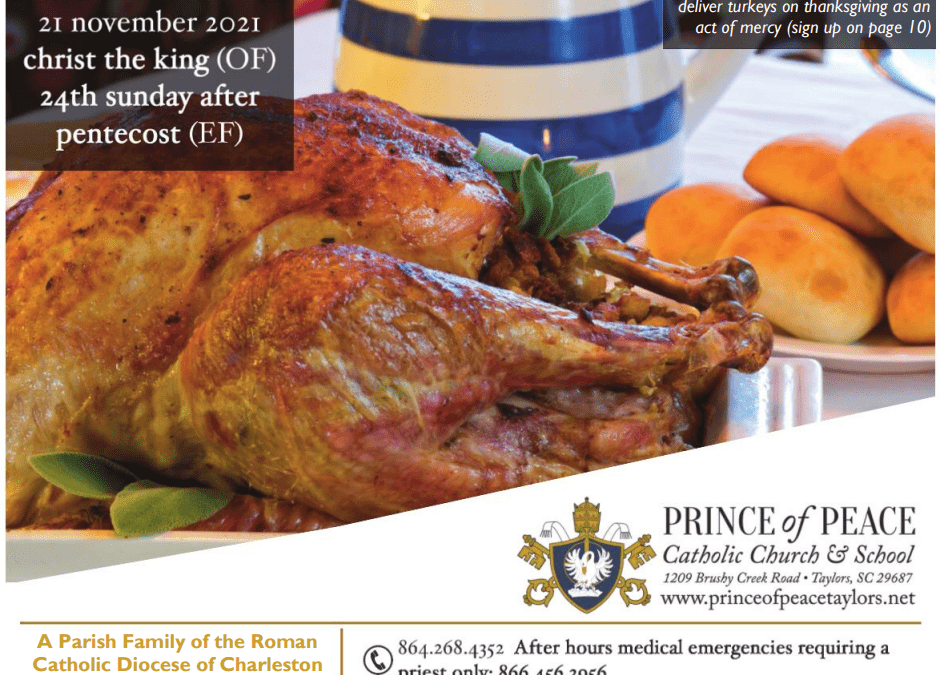
by popadmin | Nov 22, 2021 | Bulletin
Click to read this week’s bulletin: 21 November 2021 Bulletin
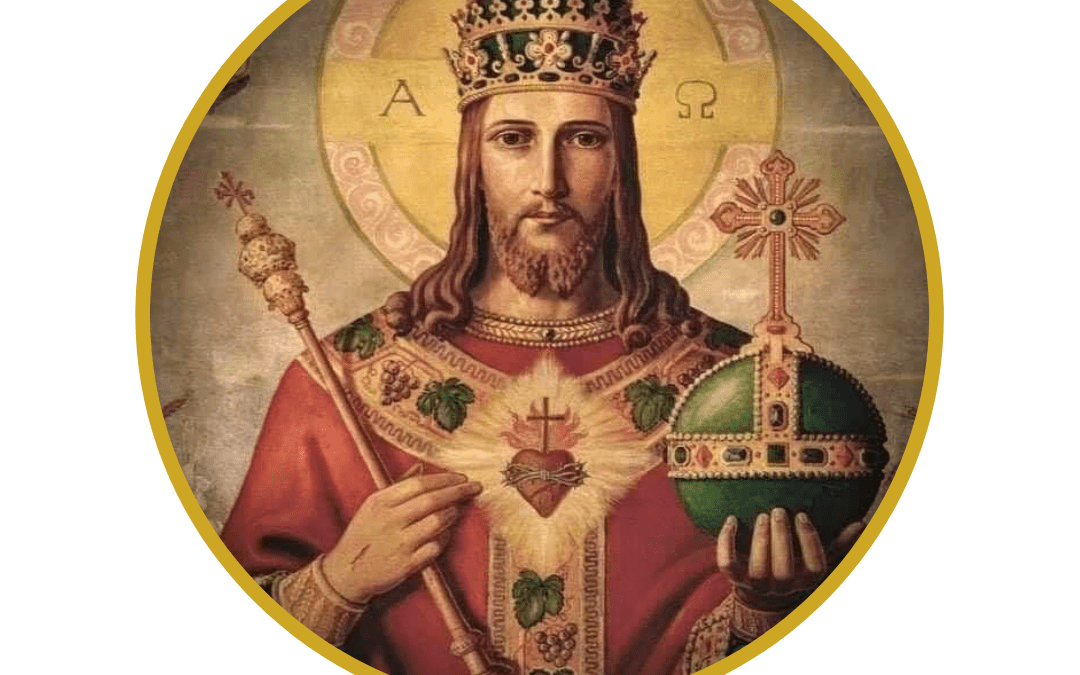
by popadmin | Nov 21, 2021 | CIC Saint Writeups
21 November: Feast of Christ the King (the Solemnity of Our Lord Jesus Christ, King of the Universe). Celebrated on the last Sunday of the liturgical year, this feast day was established by Pope Pius XI in 1925. As a response to the rise of secularization, atheism, and communism in the world and to publicly acknowledge the supremacy of Jesus Christ over all men and nations, Pope Pius XI issued the encyclical Quas Primas. This encyclical added the feast of “Our Lord Jesus Christ the King” to the Church liturgical calendar. It designated the feast to be celebrated on the last Sunday of October. This date, near All Saints’ Day and four weeks before Advent, was carefully chosen. It reminded the people that Jesus Christ is not only King of this world, reigning over the nations; He is also the eternal King, glorified by the saints in heaven, who will one day come to judge humankind. In his encyclical, the pope noted that the world’s disorder was the result of nations rejecting Christ. The pope instructed the faithful to use this annual feast as a time to consecrate themselves to the Sacred Heart of Jesus; tying the celebration to devotion to the Sacred Heart and to the living Christ in the Eucharist. In 1969, Pope Paul VI further enhanced this feast. To emphasize Christ’s universal reign, he changed the feast day name to “Our Lord Jesus Christ, King of the Universe”. He also changed the feast date to the last Sunday in the liturgical year, emphasizing even more strongly the connection between Christ’s kingship and His second advent (coming) to judge the world. Fr. Smith aptly referred to this new feast date as “the crown of Ordinary Time”. The pope also raised this feast to the highest rank of celebration on the Church calendar: that of a solemnity. Today, peace still eludes us; social, political and economic upheaval is still prevalent; and the nations continue to reject the Gospel. The world needs now, more than ever, our Christian witness to Christ the King’s rule over all things.
23 November is the feast day of Blessed Miguel Pro. It is a perfect tie-in to learn the phrase that this Mexican martyr bravely died proclaiming: “Viva Christo Rey!” (“Long live Christ the King!”)
Ideas for celebrating this feast day at home:
- Make crowns! (Or, visit Burger King today!) Here is a link for free printable Christ the King
- An easy Christ the King craft idea here.
- For a fun baking activity, make Christ the King cookie crowns.
- Set the table as if you were hosting a king for dinner: use cloth napkins, your best dishes. Light candles and fill fancy glasses with champagne or sparkling cider. You could also serve adults a Royal Flush cocktail made with Crown Royal.
- Make “Chicken á la king” for dinner: recipe here.
- Other dinner ideas “fit for a king”– a ham ‘jeweled’ with cloves; a crown roast; a very nice steak; or slow braised beef and vegetables with mashed potatoes. For dessert, a crown cake! (recipes here)
- Sing or listen to the hymn “For Christ the King” by Father Daniel Lord, from 1933. The Hallelujah Chorusfrom Handel’s Messiah is another resounding piece of music that captures the enthusiasm of this feast day: “King of Kings and Lord of Lords! And He shall reign for ever and ever.”
- Have a family procession in honor of Christ the King – idea here.
“If to Christ our Lord is given all power in heaven and on earth; if all men, purchased by his precious blood, are by a new right subjected to his dominion; if this power embraces all men, it must be clear that not one of our faculties is exempt from his empire. He must reign in our minds, which should assent with perfect submission and firm belief to revealed truths and to the doctrines of Christ. He must reign in our wills, which should obey the laws and precepts of God. He must reign in our hearts, which should spurn natural desires and love God above all things, and cleave to him alone.” (Quas Primas, Pope Pius XI)
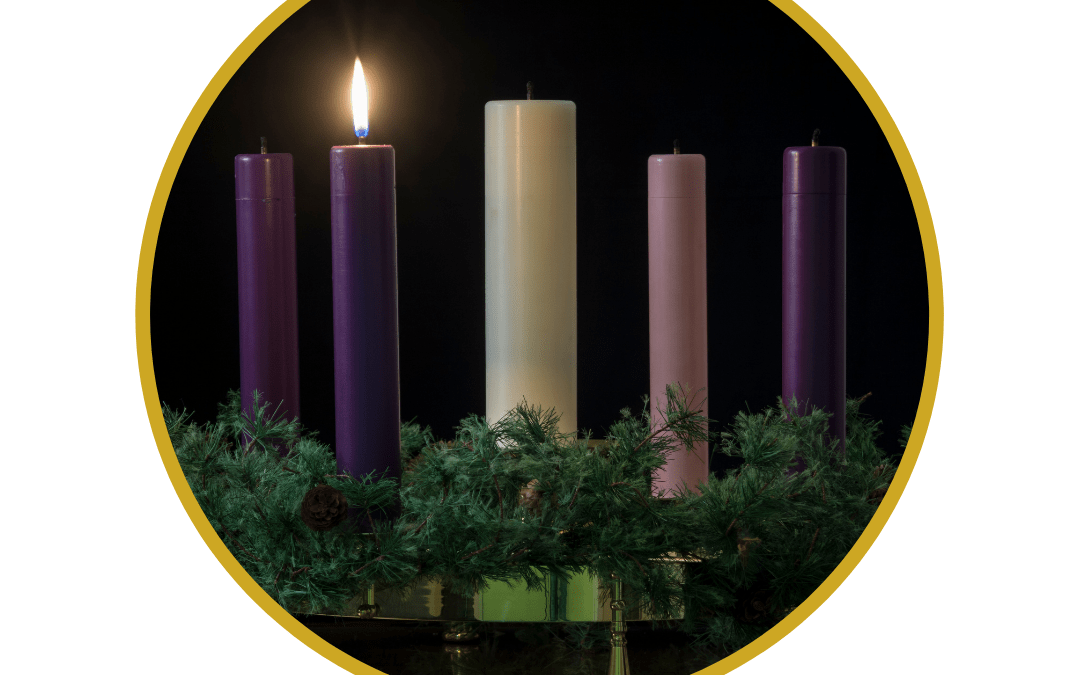
by popadmin | Nov 21, 2021 | CIC Saint Writeups
28 November: First Sunday of Advent. The word Advent comes from the Latin adventus, which means a coming or arrival. Advent is the first liturgical season of the Church Year; it begins today and ends on December 24th. Don’t skip Advent – it’s there for a reason! It is a time of hopeful, joyous preparation for the coming of the Savior. The liturgical colors of Advent are violet and rose. Violet symbolizes penance, preparation and sacrifice. Rose is used on the Third Sunday of Advent, Gaudete Sunday (Gaudete is Latin for rejoice.) The color rose signifies anticipatory joy that the waiting is half over; Christmas is near.
Advent is a time for us to prepare our minds and hearts for Jesus (through prayer, penance, fasting). We think of Advent as a time to prepare for Christmas, or the First Coming of Christ, but it should also remind us to look forward to the Second Coming of Christ.
“When the Church celebrates the liturgy of Advent each year, she makes present this ancient expectancy of the Messiah, for by sharing in the long preparation for the Savior’s first coming, the faithful renew their ardent desire for his second coming. By celebrating the precursor’s birth and martyrdom, the Church unites herself to his desire: “He must increase, but I must decrease.”” (Catechism, 524)
Here are some ideas for how you can celebrate the holy season of Advent. Remember, you don’t have to do it all—just choose a few, and see what blesses your family. The ultimate goal is to use the season of Advent to prepare our minds, hearts, and homes for the birth of Christ.
Ideas for celebrating the season of Advent in your home:
- Advent Wreath: place on your table and light the candles each night. Pray together and sing O Come O Come Emmanuel. Be sure to bless your advent wreath using this blessing.
- Advent Calendar: a wonderful visual for children to count down the days leading to Christmas.
- Jesse Tree: lots of ideas and resources online for this. It is a fantastic way to learn about Jesus’ ancestors and the Biblical events leading up to His birth. Click here for more about the Jesse Tree.
- Nativity Scene: this tradition started by St. Francis is a perfect visual to remind everyone about the meaning of Christmas. Say a blessing over your nativity set and maybe wait to add baby Jesus to the manger until Christmas morning!
- Special Sunday Advent Dinners: fix a special dinner every Sunday in Advent and eat together by candlelight. Read aloud a Christmas story, Saints story, Scripture passage or Advent devotion. Say prayers together as a family.
- O Antiphons: from the Liturgy of the Hours, these antiphons are sung or recited at evening prayer from December 17 to 23, the octave before Christmas. Each antiphon welcomes the birth of the Savior by heralding one of the ancient Biblical titles given to the Messiah (as prophesied in the OT). Click here for the antiphons.
- Las Posadas: this Hispanic tradition reflects on what it was like for Joseph and Mary on the night Jesus was born. This begins on Dec. 16 and continues through Christmas Eve. Click here for more.
- Read Christmas & Advent books to your children: Here and Here are two wonderful book lists!
- Almsgiving and acts of service: good deeds and generosity have always been an important part of preparation for Christmas. Make it a family activity!
- Celebrate Saints’ Feast Days: There are many wonderful feast days during Advent. Click here for a list. You could keep it as simple as reading about the life of the saint over dinner; or make it a more elaborate celebration with ideas you find online.
- Sacrifices for the Christ Child: fill an empty “manger” during the season of Advent – one piece of straw placed for every sacrifice or good deed. Baby Jesus will have a soft manger when he arrives on Christmas from all the good works performed during Advent! Click here for more.
Go to the Sacrament of Reconciliation as a family; pray together; attend mass; do everything you can to prepare your heart and soul for the coming of Our Savior!





Recent Comments